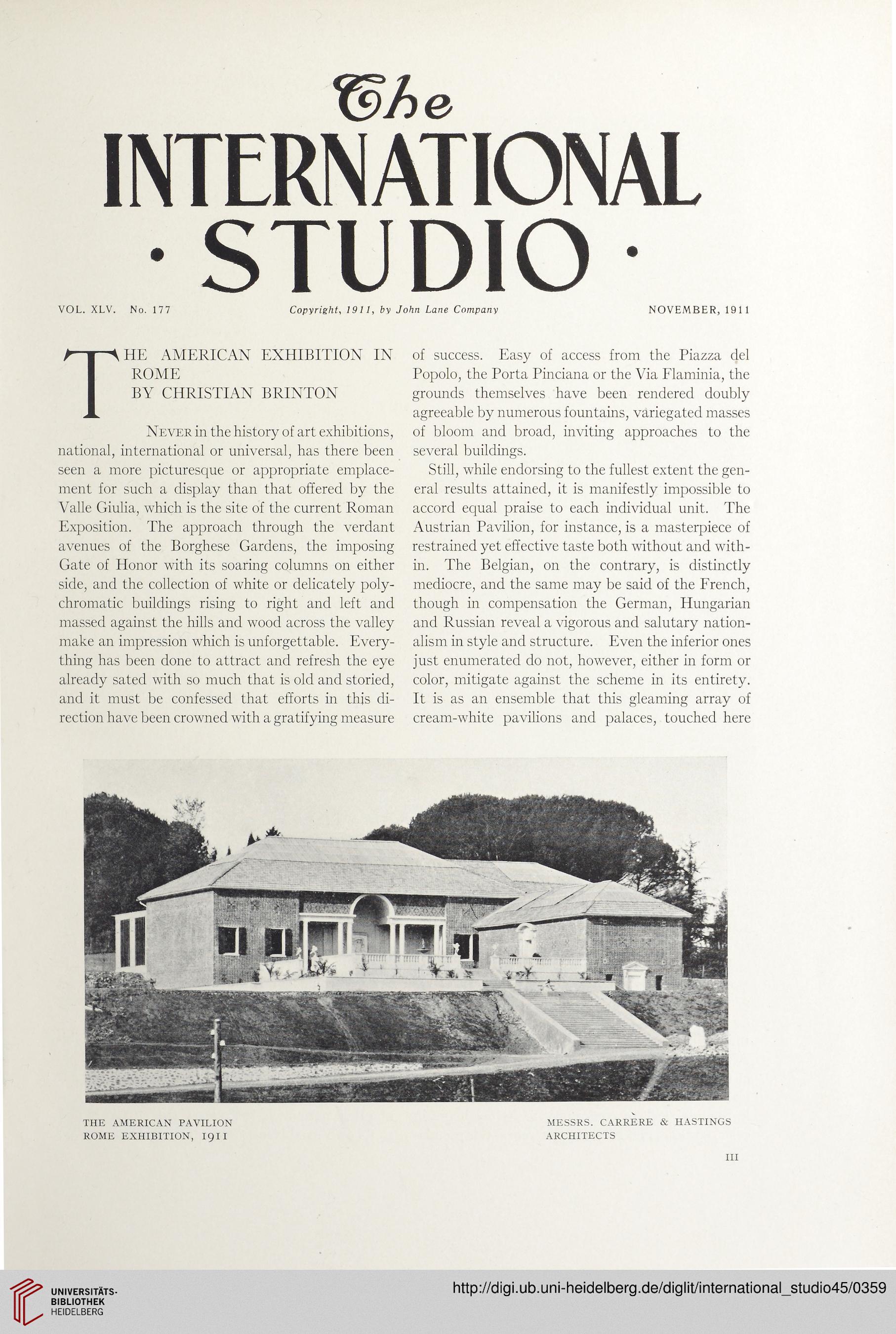IS he
INTERNATIONAL
• STUDIO
VOL. XLV. No. 177 Copyright, 1911, by John Lane Company NOVEMBER, 1911
THE AMERICAN EXHIBITION IN
ROME
BY CHRISTIAN BRINTON
Never in the history of art exhibitions,
national, international or universal, has there been
seen a more picturesque or appropriate emplace-
ment for such a display than that offered by the
Valle Giulia, which is the site of the current Roman
Exposition. The approach through the verdant
avenues of the Borghese Gardens, the imposing
Gate of Honor with its soaring columns on either
side, and the collection of white or delicately poly-
chromatic buildings rising to right and left and
massed against the hills and wood across the valley
make an impression which is unforgettable. Every-
thing has been done to attract and refresh the eye
already sated with so much that is old and storied,
and it must be confessed that efforts in this di-
rection have been crowned with a gratifying measure
of success. Easy of access from the Piazza del
Popolo, the Porta Pinciana or the Via Flaminia, the
grounds themselves have been rendered doubly
agreeable by numerous fountains, variegated masses
of bloom and broad, inviting approaches to the
several buildings.
Still, while endorsing to the fullest extent the gen-
eral results attained, it is manifestly impossible to
accord equal praise to each individual unit. The
Austrian Pavilion, for instance, is a masterpiece of
restrained yet effective taste both without and with-
in. The Belgian, on the contrary, is distinctly
mediocre, and the same may be said of the French,
though in compensation the German, Hungarian
and Russian reveal a vigorous and salutary nation-
alism in style and structure. Even the inferior ones
just enumerated do not, however, either in form or
color, mitigate against the scheme in its entirety.
It is as an ensemble that this gleaming array of
cream-white pavilions and palaces, touched here
THE AMERICAN PAVILION
ROME EXHIBITION, igi I
MESSRS. CARRERE & HASTINGS
ARCHITECTS
III
INTERNATIONAL
• STUDIO
VOL. XLV. No. 177 Copyright, 1911, by John Lane Company NOVEMBER, 1911
THE AMERICAN EXHIBITION IN
ROME
BY CHRISTIAN BRINTON
Never in the history of art exhibitions,
national, international or universal, has there been
seen a more picturesque or appropriate emplace-
ment for such a display than that offered by the
Valle Giulia, which is the site of the current Roman
Exposition. The approach through the verdant
avenues of the Borghese Gardens, the imposing
Gate of Honor with its soaring columns on either
side, and the collection of white or delicately poly-
chromatic buildings rising to right and left and
massed against the hills and wood across the valley
make an impression which is unforgettable. Every-
thing has been done to attract and refresh the eye
already sated with so much that is old and storied,
and it must be confessed that efforts in this di-
rection have been crowned with a gratifying measure
of success. Easy of access from the Piazza del
Popolo, the Porta Pinciana or the Via Flaminia, the
grounds themselves have been rendered doubly
agreeable by numerous fountains, variegated masses
of bloom and broad, inviting approaches to the
several buildings.
Still, while endorsing to the fullest extent the gen-
eral results attained, it is manifestly impossible to
accord equal praise to each individual unit. The
Austrian Pavilion, for instance, is a masterpiece of
restrained yet effective taste both without and with-
in. The Belgian, on the contrary, is distinctly
mediocre, and the same may be said of the French,
though in compensation the German, Hungarian
and Russian reveal a vigorous and salutary nation-
alism in style and structure. Even the inferior ones
just enumerated do not, however, either in form or
color, mitigate against the scheme in its entirety.
It is as an ensemble that this gleaming array of
cream-white pavilions and palaces, touched here
THE AMERICAN PAVILION
ROME EXHIBITION, igi I
MESSRS. CARRERE & HASTINGS
ARCHITECTS
III




